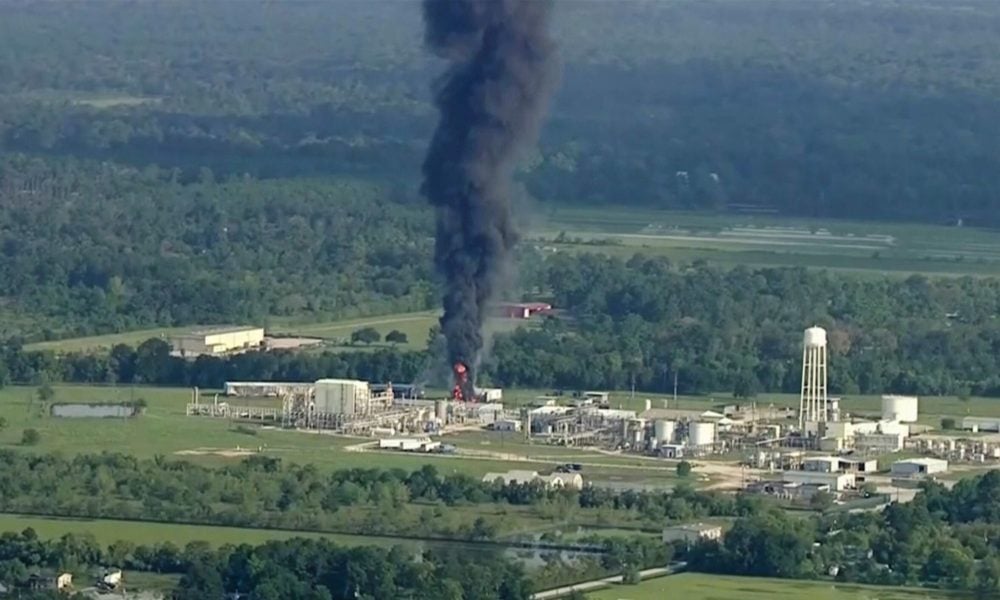It is heart wrenching to learn just how much exposure to industrial toxic chemicals and pollution that low-income communities, communities of color, and Indigenous communities experience on a daily basis. Even more criminal is how fenceline communities are regularly forced to endure the added risk of emergency situations from the fallout of violent explosions, fires, and other disasters from industrial facilities.
Our research team, in partnership with t.e.j.a.s. and Rice University co-authors, recently published research looking at the air pollution emissions from a large-scale industrial fire in Houston and the level of exposure experienced by fenceline communities during and after this devastating event. Our results show that residents in fenceline communities were exposed to large and sometimes harmful amounts of air pollution even days and weeks after the fire.
A devastating industrial fire
The industrial fire we examined occurred on March 17, 2019 at the International Terminals Company (ITC) chemical plant in Deer Park, Texas, just outside Houston, and mostly affected communities with high percentages (53 percent) of Black, Indigenous, people of color (BIPOC). BIPOC communities in Houston face a “double jeopardy” situation. Compared to whiter and richer communities, BIPOC communities experience a disproportionately high level of toxic air pollution and health risks due to chronic industrial pollution, and also live near a larger number of facilities that pose a substantial risk of a catastrophic chemical release.
When the fire broke out at the plant, it spread to several chemical tanks containing naphtha, xylene, and toluene—chemicals that are considered hazardous to human health and are often used in oil refining processes or gasoline products, among other things. The fire released a massive black smoke plume that was visible throughout the Houston region and was filled with dangerous substances like 1-butene, isoprene, and acetone. It took nearly three days to put out the fire and local government officials ordered the residents of two cities, Deer Park and Galena Park, to shelter in place for four days.
On March 22, five days after the fire initially started, a breach in a containment wall caused three tanks to reignite. Vast quantities of chemicals from the tanks leaked into Tucker Bayou (a local stream that runs into the Gulf of Mexico), along with firefighting foam that was laden with PFAS chemicals. The water was polluted with volatile organic compounds, chemicals that can evaporate quickly and cause health harms to those exposed to the fumes. This led to another shelter-in-place order for the surrounding area.
ITC fire generated huge spikes in pollution
To understand the potential health risks from this incident, we looked at every source of data that was available to us to chart the air pollution emissions from this enormous fire. This included data collected by communities, industry, the Texas Commission on Environmental Quality (TCEQ), and the Environmental Protection Agency (EPA), gathered from handheld equipment, stationary air monitors, and air monitoring vehicles (vans, buses, and a plane).
To determine possible or likely health effects, we compared these air pollution data to a variety of state and federal health standards. Specifically, we used TCEQ’s short-term air monitoring comparison values, which are designed as a screening tool to assess the potential for health and welfare effects from outdoor airborne chemical compounds. It should be noted that TCEQ’s comparison values are not as health protective as other states’ standards. For instance California’s air quality threshold for benzene is 18 times more protective than TCEQ’s short-term comparison value for benzene. But, considering that TCEQ’s values are a measure used by the state of Texas, they can provide a reference point for when air pollution levels pose a danger to the public.
All the data in our study showed that ITC fire was responsible, at least in part, for the enormous spikes in air pollution that occurred during and following the fire. This itself is an important finding since the large-scale clustering of industrial facilities in underserved communities often makes it difficult to identify a single pollution source. Another study found an increase in reported respiratory symptoms among residents of Deer Park— including persistent coughing and nose, eye, and throat irritation—during the ITC fire and for two weeks afterward. Taken together, these findings clearly link the elevated levels of air pollution emissions from the ITC fire and actual harms to the the health of residents in this fenceline community.
Communities nearby were harmed
We observed over 15 different dangerous chemical compounds associated with the ITC fire that caused elevated spikes in air pollution which, in some cases, reached levels that pose a known risk to human health. Winds both helped and hindered the situation. Ground-level winds blew from the smoldering ITC facility into residential areas in Deer Park and the Harrisburg and Manchester neighborhoods, likely concentrating the pollutants in those residential areas. On the other hand, the winds associated with the huge fire plume that rose 2,000 to 5,000 feet high mostly blew away from Houston and towards the Gulf of Mexico.
Benzene levels were the clearest indicators of potential harm to human health from the ITC fire and remained elevated for two weeks or more after the fire started. Benzene is a mostly colorless gas used in a variety of chemical production processes, particularly as a component of gasoline, and is known to cause a variety of acute and long-term health effects, including skin, eye, and lung irritation; dizziness and headaches; and cancer, especially leukemia and other cancers of blood cells. Four days after the fire started, benzene levels spiked in the Deer Park area to levels dwarfing yearly average concentration levels by over 500 times and reaching levels that pose a serious threat to human health. We even found health-harming spikes of benzene occurring near an elementary school, a church, and other residential parts of Deer Park during this time period. The emission data and our meteorological assessments both suggest that Deer Park was downwind of the ITC facility in the days following the fire, which likely exacerbated the health harms to its residents.
Levels of fine particulate matter (less than 2.5 micrograms), also called PM2.5, were elevated following the fire to around five times the yearly average. However, the levels did not appear to reach a point where they posed a direct harm to human health in nearby communities. This may have been because particulate matter from acute combustion events tends to remain airborne for a time until it has cooled down. The PM2.5 emissions may have mostly ridden the high winds out to the Gulf of Mexico. On another day with different meteorological conditions, the PM2.5 levels could well have been a lot worse for fenceline communities.
We need evidence-based policies to protect communities
Rapid and large spikes in air pollution caused by industrial fires and explosions can result in damaging health effects in nearby communities, which are frequently predominantly BIPOC communities. Our analysis offers a pathbreaking look at this serious and all-too-common phenomenon. Even after the visible smoke plumes had cleared and the fire was put out, fenceline communities continued to be exposed to large and dangerous spikes in air pollution for days and weeks afterward. After a major industrial disaster, emergency shelter-in-place orders, while necessary, are not enough by themselves to protect the health and safety of communities.
Instead, we need to craft science-based and equitable policies that can address the exposure and health disparities in communities near industrial emissions sources. Such policies should include strengthening the EPA’s Risk Management Plan Rule; requiring industrial facilities to guard against weather and climate-related risks; enhancing community engagement in chemical disaster investigations; strengthening inspections, enforcement, and penalties for violations; investing in community-led monitoring efforts; improving public input processes in facility oversight decisions; improving communication of health and safety information during and after industrial disasters; and stopping the construction and expansion of industrial facilities near residential areas.
Fenceline communities need and deserve protection from industrial disasters, and therefore it is imperative that we support community-led efforts to address these long-standing environmental injustices.

